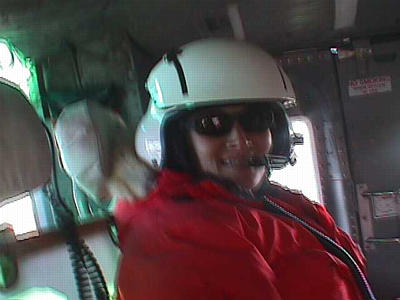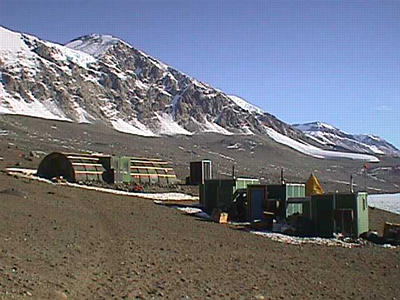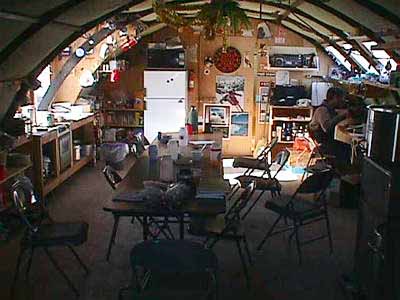3 November, 1998
We had breakfast at 7:00 am this morning, and while we were at the
Galley, I picked up the frozen bread dough promised our group. I
checked my e-mail one last time, did my laundry, and packed my bags. I
went to Crary Lab to make up my NaCl solutions for my sediment traps and
ran over to the electrical supply building to pick up some wire and
plugs for John.
I'll be drilling a hole in the ice once we get to Lake Bonney and
placing a sediment trap down the hole to collect sediment for
approximately 5 days. By placing the NaCl/Formalin solution at the
bottom of the bottle, I am making the bottom liquid more dense, and
therefore the liquid will tend to stay at the bottom of the bottle.
When the sediment falls to the bottom, it will tend to stay there, even
after I pull the bottle up. The Formalin just kills any algae or
cyanobacteria that I collect. Great planning, huh? Now I just hope it
will work. Usually, I would have to get my bottles of Formalin checked
out by Hazardous Cargo, but since my solution is such a low percentage
of Formalin, they are allowing me to pack and take the solutions without
getting checked. As a side note, I am checking the sediment in the lake
because there are liquid water pockets in the ice, and as melting
occurs, the sediment trapped in the ice is released into the water
column. Does this sediment composition match the sediment composition
of sediment on the hills surrounding the lake? That's one thing we're
trying to find out. The cyanobacteria and algae tend to congregate
around these sediment deposits, so we need to know what they are using
from the sediment to survive.
We ate lunch, I mailed some postcards, and we gathered our bags and
boxes together in the staging area. At 1:15 we were picked up to go to
the helicopter pad. We were briefed on proper helo conduct again, were
given helmets to wear (these have speaker device hookups so that you can
talk to one another and the pilot), and were weighed with all of our
gear on. The weights are very important to a helicopter pilot. They
have to distribute weight evenly and not go over a certain weight in
order to make it off of the ground.
At 2:00 pm we lifted off for the Dry Valleys. [Our pilot's names were
John and Richard]. Since we were slingloading a pack underneath the
helicopter, the pilots had to circle back around the pad and pick up the
pack lying on the ground. I could see the shadow of the pack swinging
beneath us. Our flight to Lake Bonney would be about 45 minutes, total
flying time (a little slower because we were carrying a load underneath
us).
The view from the helicopter was spectacular! I could see huge
fractures in the sea ice that seemed to stretch for miles and miles
until it hit the mountain ranges in the distance. Once we were up in
the air, we could unbuckle and move around a little. My pictures seem a
little blurry because of the movement of the helicopter. As we neared
the Valleys, I could see huge glaciers spilled into the Valleys,
stopping short of entering the Valleys. I began to see several lakes--
we went past Lake Fryxell and numerous glaciers. The ground right
beneath us had what is called frost pentagons (the way the ground cracks
under cold). Our destination was the East Lobe of Lake Bonney, and we
soon arrived at a small camp on the edge of the lake. Our parcticular
camp has a brand-new helo pad because of an incident last year involving
a helicopter not landing properly on the side of the mountain. We
unloaded the helicopter and stashed the DNF (Do Not Freeze) items in the
main Jamesway (remember, this looks like a half of a cylinder). Nina
and I began unloading the boxes into the food shelves and stocking the
outdoor freezer with the frozen food while the guys set up the tents.
The outdoor freezer was dug so that it is underground. By pouring water
into the bottom of the freezer, underneath the wood slats, a camp can
have frozen food for quite a while. You're probably wondering why we
just couldn't leave the food outside. Wouldn't it freeze? Well, not
exactly...we're going into the summer months, and while the temp. may be
below freezing, the sun shining on to the food would cause it to melt
and rot. Yuck!
I made dinner...one that is a good standby in camping situations (a
homemade chili over rice...melted cheese on top, green peas, and pears
with cinnamon and nutmeg). [Thanks, mom!]
I was quite impressed with our living accommodations. The Jamesway is
the main place that we all "hang out." It has myriads of pictures and
artifacts from previous year's groups, a stereo, a preway heater, a
stove, refrigerator, and an overall pleasing ambiance. : ) It is
evident that we need to conserve water. There are buckets underneath
the sink, collecting the water (called grey water-- this includes
dishwashing water, face washing water, etc.). The water we drink comes
from the ice on the lake. We will take turns chipping the ice and
bringing it up to the Jamesway to place in a large pot on top of the
preway for melting.
Yes, there is an outhouse...remember we must package up all wastes to
have them shipped back to the States for cleanup. We have an
exceptionally nice one, I'm told. Ours has two seats-- one for urine
and one for feces-- yes, you have to try to separate the two. There is
also a funnel set into the side of the outhouse for the men. All of the
liquid waste drains to a barrel outside. The solid wastes get packaged
up in poly -paks (big plastic bags) and shipped back to McMurdo.
The camp has 3 labs which are each heated by preways, so in case any lab
work needs to be done in camp, the facilities are there.
I picked ice berries (what the ice chips are called) in the evening,
staked down my tent (which was just easier to do with ropes tied to huge
rocks...because of the loose sediment), listened while the guys smoked
their Cuban cigars and John played his guitar. Ed tried his watercolor
experiment for the first time. He was trying to simulate what one of
his friends, Mary Ann Beckwith (professor at Michigan Tech), had tried
to do with watercolors and freezing temperatures. Somehow he was trying
to get the watercolors to freeze and watch how the ice crystals form.
His hypothesis was that the water in the watercolors would exclude the
solute (the color) and push it out to the edges. To make a long story
short, the experiment didn't work tonight....We'll try again.
Before bed, we each made ourselves a hot water bottle for the bottom of
our sleeping bags. We picked up our sleeping gear from outside (a
sleeping bag, small pillow, two pads...one of which is a ThermaRest),
and a fleece liner) and went to brave the elements (at -26 degrees C).
It was a long day. We didn't get to bed until 12:30 pm. What
mechanisms do you think the earlier explorers used to keep warm?

A helicopter that has picked up a slingload. Ours looked like this...we were carrying about 500 lbs. of food in that slingload!

Me in helicopter gear. Note the speaker system attached to the helmet. This is so that we can communicate with the pilot because it's pretty noisy otherwise. You can tell that the helicopter has started because the picture is blurry.

One of the many glaciers we saw from the helicopter as we entered the Dry Valleys. Note the abrupt cutoff at the bottom of the glacier. As the glacier pushes forward, the top breaks off to form a sort of cliff.

Lake Bonney camp-- note the Jamesway and the 3 lab facilities. The outhouse (a very important feature) is behind the Jamesway. Our tents are to the left of this on the hill.

Looking the length of the Jamesway. Working from the left, you can see the stove, refrigerator, dart board on the door, stereo, and work area. That's John you see in the picture.

The preway heater with a metal canister on top. This is our drinking water. We gather ice berries from the moat ice, place the ice chunks in the metal container, and melt our drinking water. Any sediments caught in the ice just sink to the bottom.
Contact the TEA in the field at
.
If you cannot connect through your browser, copy the
TEA's e-mail address in the "To:" line of
your favorite e-mail package.
|
